Multiple choice question for engineering
Set 1
1. The locus of a point P moving in a plane about another point O in such a way that its distance from it is constant, is called_________
a) Arc
b) Angle
c) Circle
d) Perpendicular bisector
Answer
Answer: c [Reason:] According to locus postulate: The locus of a point P moving in a lane about another point in such a way that its distance from it is constant, is a circle of some radius.
2. The locus of a point equidistant from two fixed points A and B in the same plane, is the called ___________
a) Straight line
b) Angle
c) Circle
d) Perpendicular bisector
Answer
Answer: d [Reason:] According to locus postulate: The locus of a point equidistant from two fixed points A and B in the same plane, is the perpendicular bisector of the line joining the two points.
3. The locus of a point equidistant from two fixed non-parallel straight line AB and CD is known as _______________
a) Straight line
b) Angular bisector
c) Circle
d) Perpendicular bisector
Answer
Answer: b [Reason:] According to locus postulate: The locus of a point equidistant from two fixed non-parallel straight lines AB and CD will be a straight line bisecting the angle between them.
4. Using ruler and compass how will you construct ∆ABC, if AB=3.5, BC=6 and angle ABC=60o?
a) Draw line BC=6 cm and an angle CBA=600. Cut off AB=3.5. Join AC, triangle ABC is the required triangle
b) Draw line BC=6 cm and AB= 3.5 and then angle ABC=60o, ABC is the required triangle
c) Draw line AB= 3.5cm and cut off AB = 6 cm at any point and make angle CBA=600
d) Draw angle CBA= 600 and make
Answer
Answer: a [Reason:] Figure below shows the construction:-
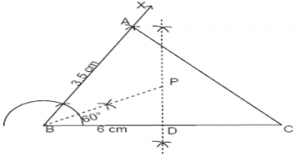
Draw line BC=6 cm with a ruler and an angle CBA=600 with the compass. Cut off AB=3.5 by compass. Join AC, triangle ABC is the required triangle.
5. Given 2 points A and B, what is the locus of points P so that angle APB is a right angle?
a) A square with points A and B
b) The circle with diameter AB
c) A rectangle with side A and B
d) A semi-circle with diameter AB
Answer
Answer: b [Reason:] The circle with diameter AB, excluding points A and B will be the locus of point AB. This point P will always make 90° angle with the circumference when the lines from two points of radius meet at P, also from circle postulate it is proved.
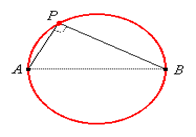
6. For all value of the co-ordinates of a moving point Pare (a cos θ, b sin θ); what will be the equation to the locus of P?
a) x2/a22 + y2/b2 = 0
b) x2/b2 + y2/a2 = 0
c) x2/b2 + y2/a2 = 1
d) x2/a2 + y2/b2 = 1
Answer
Answer: d [Reason:] Let (x, y) be the co-ordinates of any point on the locus traced out by the moving point P. then we shall have
x = a cos θ or x/a = cos θ and y = b sin θ or, y/b = sin θ
x2/a2 + y2/b2 = cos2 θ + sin2 θ or, x2/a2 + y2/b2 = 1
which is the required equation to the locus of P.
7. What curve does the locus represent if the locus of a moving point which is always equidistant from the points (2, -1) and (3, 2)?
a) Hyperbola
b) Straight line
c) Ellipse
d) Circle
Answer
Answer: b [Reason:] Let A (2, -1) and B (3, 2) be the given points and (x, y) be the
co-ordinates of a point P on the required locus. Then,
PA2 = (x – 2)2 + (y + 1)2 and PB2 = (x – 3)2 + (y – 2)2
By problem, PA = PB or, PA2 = PB2
or, (x – 2)2 + (y + 1)2 = (x – 3)2 + (y – 2)2 or, x2 – 4x + 4 + y2 + 2y + 1 = x2 – 6x + 9 + y2 – 4y + 4
or, 2x + 6y = 8 or, x + 3y = 4 ……… (1)
Clearly, equation (1) is a first degree equation in x and y; hence, the locus of P is a straight line whose equation is x + 3y = 4.
8. A point moves in such a manner that three times of its abscissa is greater by 5 than two times of its ordinate; find the equation of its locus.
a) 3y-2y=5
b) 3x-2y=5
c) 2x+3y=5
d) 2x-3y=5
Answer
Answer: b [Reason:] Here the terms abscissa and ordinate are the coordinates of a point in a two- dimensional rectangular Cartesian coordinate system where abscissa represents x-axis and ordinate as y-axis. So according to the given question the equation is as follows: 3x-2y=5.
9. What will be the geometry made by a locus of a swimmer maintaining the same distant from the lighthouse?
a) Square
b) Rectangle
c) Circle
d) Triangle
Answer
Answer: c [Reason:] The locus of the swimmer will be a circle with light house as the centre and the same distance between the light house and the swimmer as radius (locus postulate of a circle).
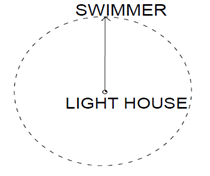
10. Which statement is correct for the locus shown in the figure below?
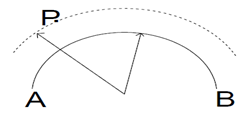
a) A point P moving in a plane about another point in such a way that its distance is constant
b) A point P moving in a plane about a fixed line as an arc with same centre
c) A point P moving in a plane about another point in such a way that its distance from a fixed line AB is constant
d) A point equidistant from two fixed non-parallel lines AB and CD in the same plane
Answer
Answer: b [Reason:] As per arc postulate regarding locus it is stated as: When the fixed line is an arc of a circle, the locus will be another arc drawn through same centre. Here fixed line is an arc AB and the locus drawn is an arc representing the circumference, produced due to point P.
11. Four bar mechanism is generally used in ___________________
a) Bicycle
b) Fan
c) Train suspension
d) Rickshaw
Answer
Answer: c [Reason:] Four-bar linkage, also called a four-bar, is the simplest movable closed chain linkage. It consists of four bodies, called bars or links, connected in a loop by four joints. Generally, the joints are configured so the links move in parallel planes, and the assembly is called a planar four-bar linkage.
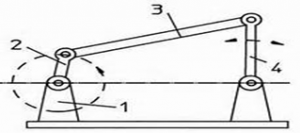
12. Chords which are ___________ from the centre are equal.
a) unequal
b) equidistant
c) one third
d) two third
Answer
Answer: b [Reason:] In the figure below, for ∆’s AOM and CON
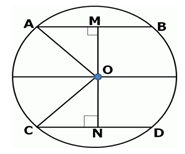
OM = ON (to prove )
OA = OC (radii of the same circle)
AM = CN OR 2AM = 2 CN ( since OM ON are perpendicular to the chords and it bisects the chord and AM = MB, CN = ND )
Angle AMO and CNO = 90°
∆AOM similar to ∆CON ( R.H.S rule)
OM = ON (CPCT) ( required).
Set 2
1. For the calculation of roof estimates start with a simple roof diagram, marking all pitch changes, valleys, ridge and hip lines, chimneys, vent pipes and other penetrations.
a) False
b) True
Answer
Answer: b [Reason:] Then measure all exterior wall sections from corner to corner, adding in any roof overhangs or bump-outs. Put these dimensions in their place on the diagram.
2. Roof slope is typically defined in inches.
a) True
b) False
Answer
Answer: a [Reason:] Roof slope, which is typically defined in inches. Some customers will know the roof slope and can supply it to you, but determining the slope yourself is easy. Unless there is a low-hanging roof eave, you may have to get on a ladder and work with a 1- or 2-foot level.
3. Pitch is defined as vertical rise (in inches) per foot of horizontal run.
a) True
b) False
Answer
Answer: b [Reason:] Slope defined as vertical rise (in inches) per foot of horizontal run. For example, A roof that rises 6 inches for every 12 inches of run is a “six-in-twelve,” or 6:12 roof, with a pitch of ¼.
4. Simple gable roofs like those found on colonial or ranch homes are easy to calculate.
a) False
b) True
Answer
Answer: b [Reason:] Simply take the ground dimensions, multiply length times width (include overhangs) and multiply by the roof pitch multiplier. For example, a 24 x 48 home with a 6:12 roof would calculate as follows: 24 x 48 = 1,152 x 1.12 = 1,290.24, or just over 1,290 square feet of roof.
5. Timber can be used as a sloping roof.
a) True
b) False
Answer
Answer: a [Reason:] A timber roof truss is a structural framework of timbers designed to bridge the space above a room and to provide support for a roof. Trusses usually occur at regular intervals, linked by longitudinal timbers such as purlins. The space between each truss is known as a bay..
Timber roof trusses were a medieval development. Earlier roofs had been supported by coupled rafters – pairs of rafters linked by horizontal beams. But such roofs were structurally weak, and lacking any longitudinal support were prone to racking, a collapse resulting from horizontal movement.
Roof made with timber
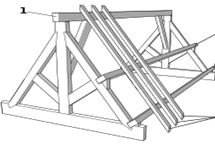
6. _______ Terrace Roof is a flat roof consisting of a layer of lime concrete over a layer of brick-on-edge laid in lime mortar.
a) Sloping
b) Madras
c) Flat
d) Arch
Answer
Answer: b [Reason:] The terrace bricks of 15*7.5*2.5cm in size are laid on-edge in diagonal rows with lime mortar 1:11/2 proportion closely packed spanning over the beams. The brickwork is then cured by sprinkling with water for a period of 10 days. After the brickwork has set, a layer of lime concrete is laid and consolidated so as to give a compact thickness of 7.5cm and cured for 6 days.
7. The figure shown below is an example of which type of roof-
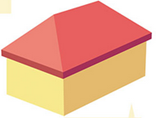
a) Butterfly roof
b) Flat roof
c) Hipped roof
d) Gambrel roof
Answer
Answer: c [Reason:] A hip roof, hip-roof or hipped roof, is a type of roof where all sides slope downwards to the walls, usually with a fairly gentle slope (although a tented roof by definition is a hipped roof with steeply pitched slopes rising to a peak).
8. The four-sided slopes are not the characteristic feature of only Mansard roofs; the _______________also come with this feature.
a) mansard roof
b) gambrel Roof
c) salt Box Roof
d) pyramid roof
Answer
Answer: a [Reason:] The four-sided slopes are not the characteristic feature of only Mansard roofs; the Pyramid roofs also come with this feature. As the name suggests, these roofs are shaped like pyramids, a roof with four sloping sides. These roofs are best-suited for smaller structures, like a farmhouse hut. These roofs are popular in the contemporary architecture, with many structures getting these roofs. The walls of these houses are symmetrical and easy to build. A lower degree pitch works best for such four-sided roofs. They would work even better if the walls were smaller and the roof made for a significant part of the house. It is not only aesthetically pleasing, but also more energy efficient.
Set 3
1. The latrine seat with flushing cistern, flushing pipes are, etc., are usually taken as ______ set for estimation.
a) Equal
b) One
c) Two
d) Separate
Answer
Answer: b [Reason:] A latrine is a toilet or an even simpler facility which is used as a toilet within a sanitation system. For example, it can be a communal trench in the earth in a camp to be used as emergency sanitation, a hole in the ground (pit latrine), or more advanced designs, including pour-flush systems.
The term “latrine” is still commonly used in emergency sanitation situations, as well as in army camps. Nowadays, the word “toilet” is more commonly used than “latrine”, except for simple systems like “pit latrine” or “trench latrine”.
The use of latrines was a major advance in sanitation over more basic practices such as open defecation, and helped control the spread of many waterborne diseases.
2. According to ISI method of measurement, the order of the sequence is _______
a) Length, breadth, height
b) Breadth, height, Length
c) Height, Length, breadth
d) Width, Length, breadth
Answer
Answer: a [Reason:] The first dimension is length (L). Length is always the longest side of the box that has a flap. The second dimension is width (W). Width is the second longest side with a flap. The third dimension is height (H). Height is the only dimension without a flap.
3. The detention period in a septic tank is assumed to be at _________
a) 20 min
b) 30 min
c) 40 min
d) 25 min
Answer
Answer: b [Reason:] A septic tank can be defined as primary sedimentation tank with large detention time (12 to 36hrs against a period of 2hrs in an ordinary sedimentation tank). In un-sewered rural and urban areas septic tanks are suitable for disposal of night soil. But sufficient water should be available as water is required for flow of the night soil from latrine to the septic tank and for proper functioning of the septic tank.
4. Cost of fittings and their fixing is specified for the following sanitary fittings ________
a) Water closets
b) Flushing pipes
c) Sinks
d) All of these
Answer
Answer: d [Reason:] (Catagorized also as hygienic fittings and tubing) were developed and are used because they are cleanable; either by dismantling a system and manually cleaning it or using a CIP (clean in place) process. They limit entrapment areas where bacteria could form or harbor. They are also corrosion resistant.
5. The value of ‘C’ of Indian type W.C. shown in the given figure is _________
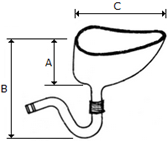
a) 400 mm
b) 550 mm
c) 250 mm
d) 500 mm
Answer
Answer: d [Reason:] We have mostly two types of commodes in our society. One is called WC and other is called Indian commode (in which you have to sit like wicket keeper sits when bowler is bowling). WC or Wc commonly refers to a Water toilet (i.e. a flush toilet). It may also refer to: Winston Churchill.
6. The area of a sloping surface of a protective embankment of mean height d, side slopes S: 1 and length L is __________
a) d x d x s
b) (d2 x (ds)2)1/2
c) L.D (1 + s2)1/2
d) 2 L.D (1 + s2)1/2
Answer
Answer: c [Reason:] An embankment dam is a large artificial dam. It is typically created by the placement and compaction of a complex semi-plastic mound of various compositions of soil, sand, clay, or rock. It has a semi-previous waterproof natural covering for its surface and a dense, impervious core. This makes such a dam impervious to surface or seepage erosion. Such a dam is composed of fragmented independent material particles. The friction and interaction of particles binds the particles together into a stable mass rather than by the use of a cementing substance.
7. The minimum width of a septic tank is taken as _________
a) 85 cm
b) 70 cm
c) 60 cm
d) 75 cm
Answer
Answer: d [Reason:] A septic tank can be defined as primary sedimentation tank with large detention time (12 to 36hrs against a period of 2hrs in an ordinary sedimentation tank). In un-sewered rural and urban areas septic tanks are suitable for disposal of night soil. But sufficient water should be available as water is required for flow of the night soil from latrine to the septic tank and for proper functioning of the septic tank.
8. The inspection pit or chamber is a manhole provided in a base drainage system for ________
a) The inspection pit or chamber is a manhole provided in a base drainage system
b) The inspection pit or chamber is a manhole provided in a base drainage system
c) The inspection pit or chamber is a manhole provided in a base drainage system
d) All of the above
Answer
Answer: d [Reason:] A hole in the floor of a garage, etc. from which the underside of a vehicle can be examined and serviced.
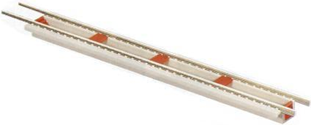
Set 4
1. Which type of machine does the figure below represents?
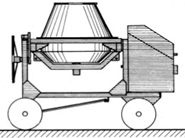
a) Purifier
b) Water tank
c) Electric Cement Mixer
d) Harvesting machine
Answer
Answer: c [Reason:] The Pro-Series 4 Cubic-Feet Electric Cement Mixer is the ideal size for mixing concrete for small to medium size projects around the house. This general duty Cement Mixer handles drywall mud, plaster, stucco, mortar, concrete and more. You could even use it on the farm to mix cattle feed or treat seeds before planting.
2. The concrete solidifies and hardens through a chemical process called hydration.
a) True
b) False
Answer
Answer: a [Reason:] To produce concrete from most cements (excluding asphalt), water is mixed with the dry powder and aggregate, which produces a semi-liquid slurry that can be shaped, typically by pouring it into a form. The concrete solidifies and hardens through a chemical process called hydration. The water reacts with the cement, which bonds the other components together, creating a robust stone-like material.
3. Reinforcement is often included in concrete.
a) True
b) False
Answer
Answer: a [Reason:] Concrete can be formulated with high compressive strength, but always has lower tensile strength. For this reason it is usually reinforced with materials that are strong in tension, typically steel rebar.
4. Mortar is composed of cement and sand, and concrete is composed of cement, sand, and gravel.
a) True
b) False
Answer
Answer: a [Reason:] Cement is the binding element in both concrete and mortar. It is made most commonly of limestone, clay, shells, silica sand and other materials.
Concrete is composed of cement, sand, and gravel or other fine and coarse aggregate. The addition of water activates the cement, which is the element responsible for binding the mix together to form one solid object.
Mortar is composed of cement and sand. When water is mixed in with this product, the cement is activated. Whereas concrete can stand alone, mortar is used to hold together bricks, stones or other such hardscape components.
5. Concrete solidifies due to a chemical reaction known as hydration. The water reacts with the cement, which bonds the other components together, eventually creating a strong stone-like material.
a) True
b) False
Answer
Answer: a [Reason:] Concrete is used more than any other man-made material in the world. As of 2006, about 7.5 billion cubic meters of concrete are made each year—more than one cubic meter for every person on Earth. The ingredients are mixed together into a paste, a bit like making dough for bread. The concrete is then poured into a frame. After a few hours it sets hard.
6. Concrete is strong in tension but weak in compression.
a) True
b) False
Answer
Answer: b [Reason:] Concrete is strong in compression but weak in tension. For some purposes it needs to be reinforced with steel rods. Reinforced concrete buildings can be made to link all the parts together, the foundations, walls, floors and roofs, but concrete construction does not make buildings earthquake-proof.
7. ‘Superplasticizers’ are chemicals which improve workability, which means the ability to shape the concrete before it has set.
a) True
b) False
Answer
Answer: a [Reason:] Pigments can change the dull grey colour. Corrosion inhibitors can reduce rusting on the steel bars. ‘Air entrainment’ is blowing little bubbles in the concrete before it sets. This helps the concrete survive the freezing and thawing of a cold climate. Blast furnace slag can be mixed with concrete. It turns the colour into almost pure white and makes the concrete stronger.
8. The quantity of cement concrete may be calculated by multiplying the area of floor by the thickness.
a) True
b) False
Answer
Answer: a [Reason:] The quantity of cement concrete calculated by multiplying the area of floor by the thickness.
9. For frog filling, for use of cut bricks, for bonding, for uniform joints, wastages, etc. 50% extra mortar may be required.
a) True
b) False
Answer
Answer: b [Reason:] For frog filling, for use of cut bricks, for bonding, for uniform joints, wastages, etc. 15% extra mortar may be required.
10. For 2.5 cm thick c.c. floor of 1:2:4 proportion, for 100 sq m, how many cement bags will be required?
a) 18
b) 28
c) 24
d) 10
Answer
Answer: c [Reason:] 100 sq m total dry volume of materials= 2.75+50%= 2.75+1.375=4.125 cu m. Therefore, cement = (4.125) / (1+2+4)=.59 cu m=.60 cu m (18 bags). For neat cement surface finishing additional 0.2 cu m (6 bags) of cement will be required.
11. For 2.5 cm thick c.c. floor of 1:2:4 proportion, for 100 sq m, how many cement bags will be required?
a) 18
b) 28
c) 24
d) 10
Answer
Answer: c [Reason:] 100 sq m total dry volume of materials= 2.75+50%= 2.75+1.375=4.125 cu m. Therefore, cement = (4.125) / (1+2+4)=.59 cu m=.60 cu m (18 bags). For neat cement surface finishing additional 0.2 cu m (6 bags) of cement will be required.
12. In the question above what amount of stone aggregate will be required?
a) 5.20 cu m
b) 1.20 cu m
c) 2.40 cu m
d) .20 cu m
Answer
Answer: c [Reason:] Stone aggregate= 0.6*4=2.40 cu m.
13. For coloured cement floor, mix pigment colour with neat surface cement in the proportion of ______ to ______is to have desired colour.
a) 1:3 to 1:6
b) 1:3 to 1:6
c) 1:3 to 1:6
d) 1:3 to 1:6
Answer
Answer: a [Reason:] White cement mixed with colour pigment of the desired proportion may also be used, but for strength it is better if ordinary Portland cement is mixed with white cement in the proportion of 1:1 to 1:3 and then to add colour pigment to have the desired colour.
14. For 10 cu m brickwork in 1:6 cement mortar, calculate the quantity of cement?
a) 0.20 cu m
b) 0.13 cu m
c) 0.56 cu m
d) 0.43 cu m
Answer
Answer: d [Reason:] Divide 3 by the sum of the numerals of the proportion of materials which gives the quantity of cement in cu m. For brickwork in 1:6 cement mortar cement=3/(1+6)= 0.43 cu m.
15. For 2.5 cm c.c. floor for 100 sq m of area and 10% for contingency what amount of cement concrete will be required?
a) 5.75 cu m
b) 2.75 cu m
c) 2.5 cu m
d) 5.0 cu m
Answer
Answer: b [Reason:] For 2.5 cm c.c. floor for 100 sq m of area the quantity of cement concrete = 100*.025=2.5 cu m. Adding 10% extra for unevenness of base concrete, the quantity comes to 2.5+.25= 2.75 cu m.
Set 5
1. Which of the following is not the nominal size of the door?
a) 2’6″*6′
b) 1’10″*5’11”
c) 4’*6’6″
d) 3’3″*6’3″
Answer
Answer: b [Reason:]
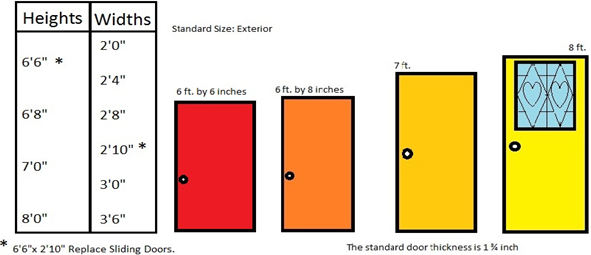
2. Size of ventilators is ____________
a) 5″*6″
b) 11″*3’5″
c) 4’*1′
d) 4’*2′
Answer
Answer: d [Reason:] Nominal sizes are as mentioned below.
Nominal length: 225, 325, 425, 525, 625, 825,
1025, 1225 mm
Nominal height: 125, 225, 325, 425, 525 mm.
3. Size of chowkhat sections for door and window is __________
a) 2cm*1.5cm
b) 10.16cm*10.16cm
c) 2.8″*1.4″
d) 10/3″*2/3″
Answer
Answer: b [Reason:] Nominal sizes of chowkhat is as mentioned below.
• 4 inch x 2.5 inch
• 4 inch x 3.0 inch
• 5 inch x 2.5 inch
• 10inch x2.0 inch
• Custom size is available.
4. Size of C.S windows is ___________
a) 5″*6″
b) 4’*2′
c) 4’*2.5′
d) 11″*3’5″
Answer
Answer: b [Reason:] A casement window is a window with a hinged sash that swings in or out like a door comprising either a side-hung, top-hung (also called “awning window”; see below), or occasionally bottom-hung sash or a combination of these types, sometimes with fixed panels on one or more sides of the sash. In the USA, these are usually opened using a crank, but in parts of Europe they tend to use projection friction stays and espagnolette locking. Formerly, plain hinges were used with a casement stay. Handing applies to casement windows to determine direction of swing; a casement window may be left-handed, right-handed, or double. The casement window is the dominant type now found in modern buildings in the UK and many other parts of Europe.
5. Which is not the nominal thickness of D.P.C?
a) 2cm
b) 2.5cm
c) 4cm
d) 2.5″
Answer
Answer: d [Reason:] Damp proofing is accomplished several ways including:
• A damp-proof course (DPC) is a barrier through the structure designed to prevent moisture rising by capillary action such as through a phenomenon known as rising damp. Rising damp is the effect of water rising from the ground into property. The damp proof course may be horizontal or vertical. A DPC layer is usually laid below all masonry walls, regardless if the wall is a load bearing wall or a partition wall.
• Integral damp proofing in concrete involves adding materials to the concrete mix to make the concrete itself impermeable.
• Surface coating with thin water proof materials for resistance to non-pressurized moisture such as rain water or a coating of cement sprayed on such as shotcrete which can resist water under pressure.
• Cavity wall construction, such as rainscreen construction, is where the interior walls are separated from the exterior walls by a cavity.
• Pressure grouting cracks and joints in masonry material.
6. Which size cannot be possible for a room?
a) 3.0m*3.60m
b) 12’*14′
c) 360cm*360cm
d) 10’*9′
Answer
Answer: d [Reason:] Standard sizes of rooms is as given below.
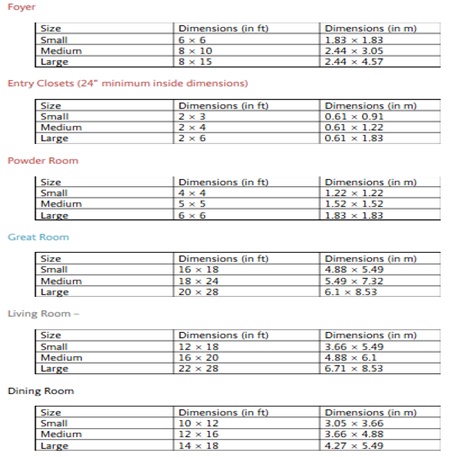
7. Height of plinth can be _______
a) 48″
b) 11′
c) 1′
d) .5″
Answer
Answer: c [Reason:] The plinth height is provided essentially to protect the superstructure from dampness which may seep in due to direct contact from the ground. The top of plinth level is provided with damp proof course which is an additional protection against dampness. Plinth height also prevents storm water/overflowing drainage from directly entering the building in case of heavy rainfall. Generally plinth level is provided at about 300–450 mm above finished ground level. It is suggested that plinth level should be decided by considering the top of the road level, the former should be kept atleast 150 mm higher.
8. Insulation layer in roof can be _____________
a) 2.5cm
b) 1.5″
c) Only a
d) 2.5cm and 1.5”
Answer
Answer: d [Reason:]
Insulation acts as a barrier to heat flow and is essential for keeping your home warm in winter and cool in summer. A well-insulated and well-designed home provides year-round comfort, cutting cooling and heating bills by up to half. This, in turn, reduces greenhouse gas emissions.
Climatic conditions influence the appropriate level and type of insulation. Establish whether the insulation is predominantly needed to keep heat out or in (or both). Insulation must cater for seasonal as well as daily variations in temperature.
Total Views: 22
